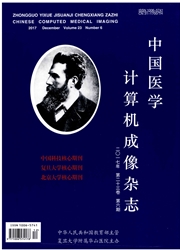

 中文摘要:
中文摘要:
目的:探讨弥散峰度成像(DKI)在检测鼻咽癌放疗后颞叶灰质与白质微观结构变化中的诊断价值。方法:本研究共纳入60例鼻咽癌患者和20例健康志愿者。根据放疗完成至DKI检查时间间隔将60例鼻咽癌患者分为三组,每组20人:A组(1周)、B组(6个月)和C组(12个月),所有鼻咽癌患者和对照组志愿者常规磁共振检查均未发现明显异常。由2名放射科专家在协商一致情况下手动勾画颞叶灰质和白质感兴趣区,计算感兴趣区MD、MK和FA值,并进行统计学分析。结果:与正常对照组相比,放疗结束后1周颞叶灰质与白质的MK值增加,放疗结束后6个月和12个月时MK值降低。放疗结束后1周MD值高于正常对照组,但放疗后6个月和12个月时MD值接近正常。结论:DKI能够动态监测鼻咽癌放疗后不同时期颞叶灰白质微观结构变化,定量测量MD和MK有助于早期发现常规磁共振无法显示的隐匿性损伤,为临床早期诊断和早期干预提供更客观的影像学证据。
 英文摘要:
英文摘要:
Purpose: This study aimed to evaluate the potential value of diffusion kurtosis imaging (DKI) in the diagnosis of radiation-induced changes in the grey and white matter of temporal lobe after radiation therapy in patients with nasopharyngeal carcinoma (NPC). Methods: Sixty patients with NPC and 20 normal control individuals were enrolled. Patients with NPC were divided into 3 groups according to the duration between the time of radiotherapy and DKI scanning: group A (1 week, n=20), group B (6 months, n=20), group C (12 months, n=20). Two neuroradiologists drew the region of interest (ROIs) manually in the temporal lobe white matter and grey matter on the DKI images. Mean diffusion (MD), mean kurtosis (MK) and fractional anisotropy (FA) of the ROIs were measured. Results: Compared to that of the normal control group, MK values in grey and white matter were significantly higher at 1 week after radiotherapy and significantly lower at 6 months and 1 year after radiotherapy in patients with NPC, whereas the MD values in grey and white matter were significantly lower at 1 week after radiotherapy and returned to normal at 6 months and 1 year after radiotherapy. Conclusions: DKI canbe used to detect radiotherapy-induced changes in both the grey and white matter of temporal lobe in patients with NPC. MK and MD values may represent reliable indicators for the early diagnosis of radiation-induced temporal lobe changes.
 同期刊论文项目
同期刊论文项目
 同项目期刊论文
同项目期刊论文
 期刊信息
期刊信息
